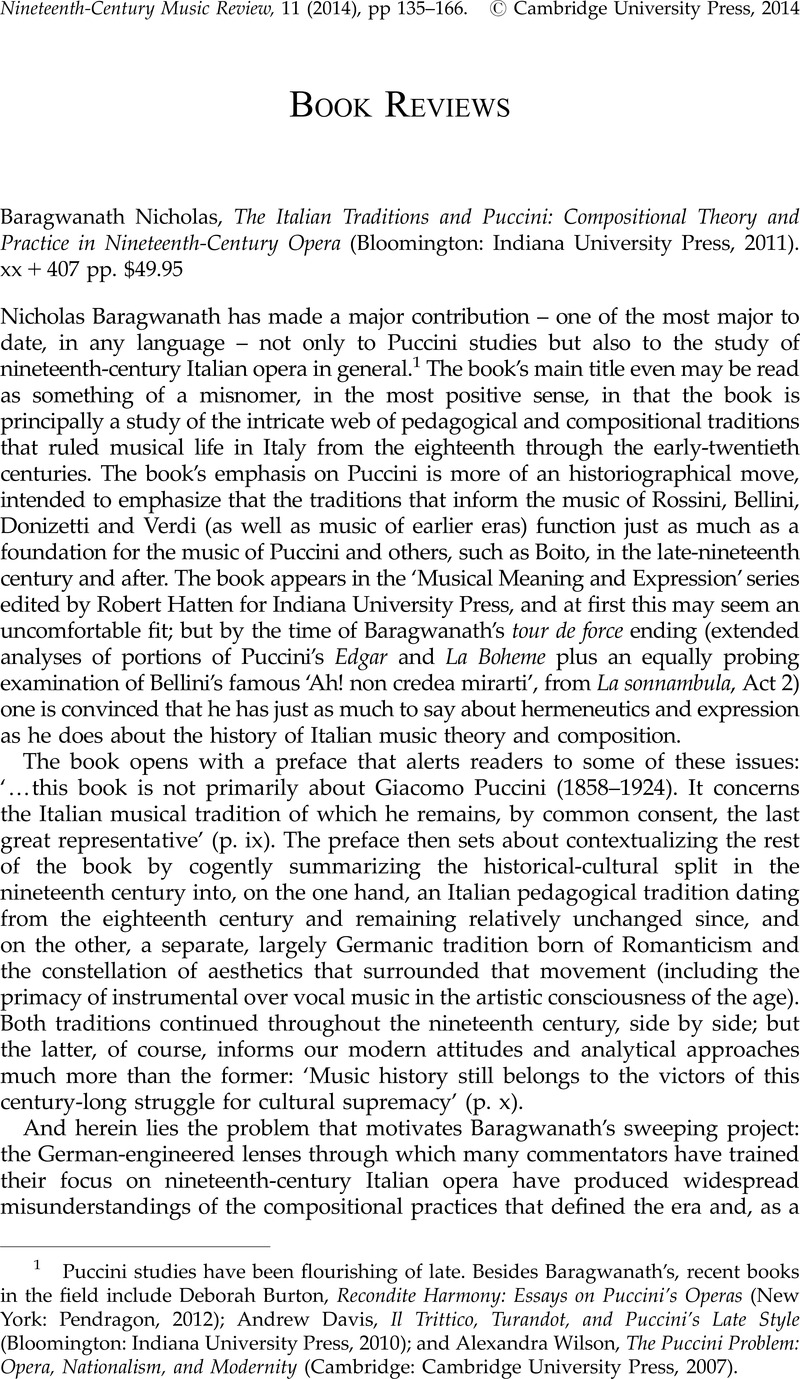No CrossRef data available.
Article contents
Baragwanath Nicholas, The Italian Traditions and Puccini: Compositional Theory and Practice in Nineteenth-Century Opera (Bloomington: Indiana University Press, 2011). xx + 407 pp. $49.95
Published online by Cambridge University Press: 02 April 2014
Abstract

- Type
- Book Reviews
- Information
- Copyright
- Copyright © Cambridge University Press 2014
References
1 Puccini studies have been flourishing of late. Besides Baragwanath's, recent books in the field include Burton, Deborah, Recondite Harmony: Essays on Puccini's Operas (New York: Pendragon, 2012)Google Scholar; Davis, Andrew, Il Trittico, Turandot, and Puccini's Late Style (Bloomington: Indiana University Press, 2010)Google Scholar; and Wilson, Alexandra, The Puccini Problem: Opera, Nationalism, and Modernity (Cambridge: Cambridge University Press, 2007)CrossRefGoogle Scholar.
2 Asioli, Bonifazio, Il Maestro di composizione, ossia seguito del Trattato d'armonia, 3 vols. (Milan: Ricordi, 1832)Google Scholar; Galeazzi, Elementi teorici-pratici di musica con un saggio sopra l'arte di suonare il violin analizzata, ed a dimostrabili principi ridotta, opera utilissima a chiunque vuol applicar con profitto alla musica e specialmente a’ principianti, dilettanti, e professori di violin, 2 vols (Rome: Pilucchi Cracas, 1791 [vol. 1]; Rome: Michele Puccinelli, 1796 [vol. 2]).
3 Friedrich Lippmann, ‘Der italienische Vers und der musikalische Rhythmus: Zum Verhältnis von Vers und Musik in der italienischen Oper des 19. Jahrhunderts, mit einem Rückblick auf die 2. Hälfte des 18. Jahrhunderts,” Analecta musicologica 12 (1973): 253–369; 14 (1974): 324–410; 15 (1975): 298–333; in Italian as Versificazione italiana e ritmo musicale: i rapporti tra verso e musica nell'opera italiana dell'Ottocento, revised ed., trans. Lorenzo Bianconi (Naples: Liguori, 1986).
4 Staffa, Giuseppe, Metodo della Scuola Napolitana di composizione musicale: Parte seconda: Trattato di composizione (Naples: Carlo Lista Vico Gerolomini, 1856)Google Scholar.
5 On the bass-less melody in ‘Sono andati?’, see, for example, Drabkin, William, ‘The Musical Language of La Bohème’, in Giacomo Puccini: La Bohème, ed. Arthur Groos and Roger Parker (Cambridge: Cambridge University Press, 1986)Google Scholar: p. 87.
6 The point of departure on this subject is Rabinowitz, Peter J., ‘Truth in Fiction: A Reexamination of Audiences’, Critical Inquiry 4/1 (1977): 121–141CrossRefGoogle Scholar.
7 The topos definition is from Monelle, Raymond, ‘The Search for Topics’, in Monelle, The Sense of Music: Semiotic Essays (Princeton: Princeton University Press, 2000)Google Scholar: 14.


